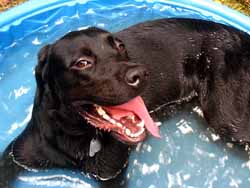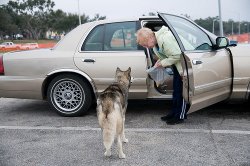How to Give CPR to a Dog or Cat
Accidents happen, and sometimes it’s our pets that get in trouble. They can drown, choke, get electrical shocks, lose consciousness, stop breathing, etc. If something like this happens, it’s good to know how to give CPR to a dog or cat. Giving CPR to a dog or a cat is very similar to how we do it in humans. If your pet is unconscious, check for breath. Watch their chest or feel for breath or check the gums, which will turn blue from lack of oxygen.
(check the video at the bottom)
1. The first thing you have to do to perform CPR on a dog or cat is lay them on their right side on a flat surface and extend the head and neck to form an airway. Then check for obstructions. They might have swallowed something that got stuck in their throat.
Be aware that dogs have little bones at the base of their tongue that can be confused with a foreign object. Do not try to remove or force anything out unless you can see it.
-If it’s a small dog or a cat, hold him upside down and shake him to try to remove the object. Be careful if you try to use your fingers, because you might push the obstruction further down.
-If it’s a large dog, pull their tongue outward and see if this action dislodges the object. You can try using pliers to remove the obstruction, again, being careful as to not push the object further down.
You can perform the Heimlich Maneuver on the dog or cat and try to dislodge the foreign object.
If there are no obstructions and the air passage is clear:
2. Give them artificial respiration.
With a small dog or cat, you can cover their nose and mouth with your mouth and blow air into them. Give short and shallow breaths every three seconds, just hard enough to make their chest rise until they start breathing on their own.
With a large dog, hold the muzzle to hold the mouth shut. Put your mouth on the nose, covering it completely, and blow gently into their nostrils. The chest should rise. Use longer and deeper breaths every three seconds until they start breathing on their own.
Constantly check their pulse. You can try feeling the heart beats on their chest, or check for a pulse in the inner side of the thigh, near the junction of the leg to the body. The pulse of the femoral artery can be difficult to feel in cats. Use your index and middle fingers, not your thumb.
3. If there’s no pulse, start chest compressions.
On large dogs, lay them on their side and give the compressions placing one hand on top of the other over the widest portion of the rib cage, not the heart. On a smaller dog or cat, place your hand on the rib cage over the heart and the other hand on top. On a puppy or a kitten, put your thumb on the chest and compress, being very careful not to use excessive force.
The rate of compressions depends on the size of your pet:
If they are over 60 lbs, give 60 compressions per minute.
From 11 to 60 lbs, give from 80 to 100 compressions per minute.
Less than 10 lbs, give 120 compressions per minute.
Alternate breaths and compressions. Just like a human, you should give 30 compressions, 2 breaths. Continue the process until you can get the animal to respond or to start breathing on its own.
As soon as the dog or the cat responds, bring him or her to the vet immediately.
Watch the following video to see an example of how to give CPR to a dog or cat
Yes, You Can Talk to Your Pets
All animal lovers believe that their pets understand most of what they say to them, but it is a proven fact that both dogs and cats are capable of learning human language, not to the extent a child does, of course, but enough to be able to communicate. Your pets will never have the same extensive vocabulary as people, but they are capable of learning dozens if not hundreds of words. Yes, you can talk to pets.
Your pets love to interact with you, and talking to them often gives them the chance to be a part of your world and feel a lot closer to you.
Your pets crave the sound of your voice. They enjoy the attention you are giving them when you talk to them. The natural rhythm of conversation soothes them and pets detect the love and affection in your voice.
 People tend to change their tone and use very simple words when they speak to their pets, just like they do when they speak to children. However, there is no need to restrict your vocabulary since they are very good at understanding what you are saying. Obviously, they don’t understand the words immediately, they need a little coaching to be able to understand what you’re saying. They need to be taught a little.
People tend to change their tone and use very simple words when they speak to their pets, just like they do when they speak to children. However, there is no need to restrict your vocabulary since they are very good at understanding what you are saying. Obviously, they don’t understand the words immediately, they need a little coaching to be able to understand what you’re saying. They need to be taught a little.
At first, talk to them with simple and short words, but you don’t have to use only childish vocabulary. The more extensive vocabulary you use, the more words your pets will learn, and they will also learn to understand your voice inflections a lot better, so there’s no need to talk with an overly infantile voice as we tend to do…. you know: “Who’s momma’s baby? Who’s the baby?” Our tone of voice is important, however. If we use a high pitched, happy voice, it will get them excited. If we lower our pitch and speak calmly, we’ll be able to sooth them, if we use s stern and harsh tone, they will know they did something wrong. Keep in mind that even though pets are capable of understanding words and phrases, they can’t relate them to something that they can’t see. You can’t scold your cat for something he did 10 minutes ago, but he will understand if you scold him at the very moment he’s caught doing the bad deed.
One thing that’s important is that both dogs and cats need to hear the same words and phrases repeatedly to learn them. Just like when you say to your family “Dinner’s ready”, somehow they know what’s coming because they have experienced that whenever you say that phrase, food’s on the table. This means that in order for them to really understand the meaning of a word or phrase, it has to be followed by an action. If you tell your cat “come here”, he won’t know what you’re talking about unless you coach him to come to you in  some way. It’s very important that the first word you use when you talk to your pets is their name, that’s the way to get their attention, but once you get their attention, you need to follow up with some action so that they won’t start tuning out knowing that nothing happens when they turn to see you.
some way. It’s very important that the first word you use when you talk to your pets is their name, that’s the way to get their attention, but once you get their attention, you need to follow up with some action so that they won’t start tuning out knowing that nothing happens when they turn to see you.
You can also use hand signals and body language to communicate with your dog or cat. For instance, when you want him to stop, stand still and give them a palm-out signal. If you want them to come to you, bend down and pat your knees.
Another thing you can do to communicate is learn their language. With dogs it’s a little harder. If you try to bark or growl they’ll just look at you as if you’re crazy, dog language has a very distinctive accent, you might say. But your cats are a different story. If you approach a cat using cat language, look at her sideways and blink your eyes to give a peaceful greeting. If you want her to relax, purr, or if you want to scold her, hiss.
Whatever language you decide to use, whether it’s body language, hand signals, cat language dog language or human language, it’s important that you communicate with your pets. It will definitely deepen your bond and make your life together a lot more interesting.
Keep Your Dog Cool Under Extreme Heat
The Summer months are very unpleasant for all of us, right? We tend to look for air conditioned buildings, or go to the beach and cool off by the ocean, or the pool. Imagine how it would be to be outside, in 90˚ to 110˚ heat with a sweater on, and not being able to sweat to cool off? Not a nice thought…
Imagine just how your dogs feel during extreme heat? Their lives depends on you. You should do your best to keep them cool, since they can’t do it by themselves.
If you must keep your dog outside, please make sure he has a good place with cool shade. The temperature in the shade might be 10 or 15 degrees cooler, but that’s still too hot in a 110 degree day. A wooden or plastic dog house does not provide a cool spot, just the contrary, unless you are able to connect a fan close by to help keep the area cool, or give them a cool bed. If the patio is all concrete, provide them with a mat or grassed area where they can be without burning their paws. Water is tremendously important. If you have a hose, there are special waterers that provide continuous cool and fresh water without any waste. Even in the shade, a bowl of cool water will become a bowl of hot tea in a few minutes.
However, even if you don’t like your dog to be inside the house, please consider closing off the kitchen or some small area of the house for them to spend the day during the Summer. If you go out, don’t turn off the air conditioner, or at least leave them with a good fan and don’t forget the cool water.
These are some things you should keep in mind:
-Avoid taking your dog for walks during the hottest hours. Walk them in the early morning or later in the afternoon.
– Walk them on grass. Asphalt can get too hot and really burn their paws.
Walk them on grass. Asphalt can get too hot and really burn their paws.
-Using booties to avoid their paws from burning, can do more harm than good. They release sweat through their paws, and if they are covered too long, they could suffer heatstroke.
-Bring water with you on the walk for both of you.
-Keep a kiddie pool full of water in a shaded area.
-Short haired, pale dogs are susceptible to sun burn. Apply pet approved sunscreen on the most exposed areas, like the bridge of the nose and the tips of the ears.
-Breeds like Bulldogs, Pugs, Boxers and other snub-nosed dogs can over heat a lot faster due to their shorter airways. Weimaraners are also very susceptible to heat stroke.
-Dogs with dark coats can absorb heat a lot quicker than lighter colored dogs, as well as thick coated dogs.
 -Do not shave your dog for the Summer. Even in the heat, their coats serve an important purpose. Just do your best to keep them cool. Also consider that in some breeds, once you shave off their coat, it will never grow back the same, as is the case with Pomeranians.
-Do not shave your dog for the Summer. Even in the heat, their coats serve an important purpose. Just do your best to keep them cool. Also consider that in some breeds, once you shave off their coat, it will never grow back the same, as is the case with Pomeranians.
And the most important thing you can do for your dog during hot days, is never, NEVER, leave the dog in the car for any amount of time… even in the shade, and even with the windows cracked. The interior of a car can reach 170 degrees in less than 15 minutes in 80 degree weather. It just takes a few minutes for a dog to succumb to heat stroke. They are better off staying home without you in a nice air conditioned place.
Learn the signs of dehydration on dogs: heavy panting, difficult breathing, vomiting or confused behavior. If you catch it early, you can avoid complications. Take them to the vet as soon as you notice this signs. However, you will be better off just helping them avoid the heat altogether.
Should I Choose a Dog or a Cat as a Pet?
You want to adopt a pet, but how do you decide if you want a dog or a cat? Well, the obvious answer lies within you: are you a “dog person”, or a “cat person”? Most people already know this, but if you really never thought about it, let’s see what advantages or disadvantages each species has to help you decide.
Cats and dogs have different needs and characteristics. One thing that applies to both is that they all need attention, you need to budget for their veterinary care, food and emergencies, you need to clean after them, and you have to love them unconditionally.
Now, for the differences.
Dogs:
Your lifestyle will definitely determine if you should have a dog or a cat as a pet. If you like to travel a lot, or work all day, a dog is not for you.
-Different breeds have different characteristics, you should choose one that matches your personality and lifestyle.
-If you travel, boarding a dog is quite expensive.
-A dog needs company and attention. If you have a dog and leave him home alone all day, you will have a very unhappy pet.
-Dogs need exercise. More or less depending on the breed.
-You need to walk them at least a couple of times daily for them to do “their thing”.
-Dogs need to be trained, socialized and housebroken.
-Dogs like to play. They need to be stimulated and love to play with their masters.
-Some dogs shed a lot. You have to be prepared to clean after them constantly.
 -Dogs need to be groomed often. You need to brush their coat, bathe them, and brush their teeth.
-Dogs need to be groomed often. You need to brush their coat, bathe them, and brush their teeth.
-A small dog is a little easier to take care of, but it still needs walks, play and attention. A big dog obviously needs more space.
-A small dog eats very little, but a big dog will eat a lot. You have to be ready for the expense of feeding.
-Dogs love to ride in the car and go hiking, swimming and all kinds of outdoor activities.
-A dog will greet you happily every time you come home, he will want to sleep with you, and in general, share everything with you.
-There are many dog parks where you can take your pet to run and play.
-Dogs are protective of their humans and will be faithful forever.
Cats:
If you work outside your home or travel a lot, and the pet needs to be alone for many ours, a cat might be for you.
-If you travel, boarding a cat is not as expensive, depending on the facility. They could be left at home with a pet sitter visiting once or twice a day.
-All cats have different personalities. Some are affectionate lap cats, and others are more energetic and don’t like to be petted as much. Choose carefully.
-A cat can be left alone to sleep most of the day.
-Cats are independent, but that does not mean you can live them alone all day and not pay any attention to them. They do love company.
 -Cats need to play and be stimulated. They entertain themselves more easily without being destructive.
-Cats need to play and be stimulated. They entertain themselves more easily without being destructive.
-Cats are very easily trained to use their litter box, which requires cleaning at least once a day.
-There’s no need to walk them, though some cats like to walk on a leash.
-Some cats are easily trained to do tricks. Some are very good at fetching.
-Cats eat very little depending on their size, but never as much as a dog.
-Cats don’t need to be bathed, but they do need to get brushed and you need to brush their teeth regularly.
-You can get a cat used to car rides, but they mostly prefer to stay at home.
-Cats can live in small apartments. It’s actually better to always keep them indoors.
-Contrary to popular belief, cats will greet you at the door and follow you around like a dog.
-Cats are playful and a delight to watch as they jump and run and chase.
-You need to have space for a litter box in a well ventilated area, away from kids and out of site.
-Cats like to have scratching posts or kitty condos.
-Cats love to cuddle.
-Cats can be very protective of their humans and will be faithful forever. They do get attached to their owners.
I am one of those strange people that is a cat person and a dog person. I love them both with all my heart and enjoy their different personality traits. I have never had two cats with the same personality, it’s always an adventure to get to know them. And dogs for me, are the best company you can ever ask for. But one thing is certain, both species are incredible, and everybody should have the experience of living with one or both of them at some point.
The Importance of Good Dental Care for Pets
Thanks to all the new preventive medicine we can count on, our pets live longer, healthier lives, so much so that now some of the most severe medical issues pets can have are related to their dental health. Cleaning our pet’s teeth routinely can make a huge difference in their health and well being. By routinely, I mean daily, but don’t worry, once you get a hang of it, it shouldn’t take you more than a couple of minutes. Keep in mind, however, that even if you give them daily home cleaning, you should always take your pet to the vet at least once a year for a complete checkup, and if needed, a professional teeth cleaning.
Dogs and cats don’t get cavities often, if at all, but they do get gum disease and tartar can build-up excessively on the teeth. That is the main reason to provide good dental care. Plaque is formed when food particles and bacteria accumulate along the gumlines. If plaque is not removed in 2 to 5 days, it turns into tartar, which gets adhered to the teeth and it’s not as easy to remove. Tartar irritates the gums, and this is what causes gingivitis. You should check for reddening of the gums around the teeth and bad breath. Once tartar has developed, the cleaning should be done by your vet who can remove the tartar and polish the teeth. Once the tartar builds up under the gums, it causes a separation of the gums from the teeth and forms pockets, where even more bacteria can grow. At this point they have developed periodontal disease. Besides being very painful, this can cause tooth loss, abscesses and infections. As the bacteria increases, it can even reach the bloodstream, which can cause an infection of the liver, the kidneys, or the heart valves. Only your veterinarian can stop the advance or stop the disease.
So, what kind of dental care should you provide your pets?
Take your pet to the vet for regular checkups, which should include dental exams.
Have their teeth cleaned by the vet at least once, and then follow up with routine home dental care.
As I’ve said, your pet needs routine dental care at home, but for a good start, the teeth should be clean. If you’ve been taking care of their teeth since they were babies, maybe you are in good shape, but chances are you’ve neglected their teeth for a while. If they have already developed tartar, it would be important to have it removed by a vet. To perform a cleaning, your vet will anesthetize your pet, take x-rays, and proceed with the cleaning. The tartar will be removed from above and below the gumline. Then their teeth will be polished to remove any scratches caused by the cleaning to avoid accumulation of bacteria. Then the vet will tell you the best dental care program for your pet.
Now that their teeth are clean, you should start looking for warning signs in their mouths: bad breath, red and swollen gums, tartar around the gumline, and pain or bleeding when you touch the gums or mouth.
 Let’s start with the food. Kibble is definitely better for your pet’s dental health. Many foods have special properties to keep their teeth as clean as possible. There are also many treats you can give them that will aid in removing plaque and prevent tartar build up, as well as toys made especially to help in plaque removal.
Let’s start with the food. Kibble is definitely better for your pet’s dental health. Many foods have special properties to keep their teeth as clean as possible. There are also many treats you can give them that will aid in removing plaque and prevent tartar build up, as well as toys made especially to help in plaque removal.
Even when they eat the right kinds of food and play with the right toys, you need to brush their teeth every day. This is the most important preventive measure you can take.
How to brush your dog’s teeth:
First, you have to get him used to the process if you haven’t done it before. Start by gently massaging his teeth and gums for a few seconds and see how he reacts. If the fusses, don’t force him and try again the next day. In three or four tries, he should be more accustomed to your finger inside his mouth, so you can now progress to a brush. There are many types of brushes for dogs at your pet shop, and if it’s a small dog, you might try with a piece of sterile gauze. There are also special toothpastes for dogs with yummy tastes like chicken or liver. Never use human toothpaste! Pay attention to the big teeth in the back. Don’t worry too much about the inside, but pay special attention to the outside surface of the teeth. You can do a couple of teeth a day if he doesn’t like the process too much at first. Eventually, he’ll sit tight for the whole cleaning and you’ll be able to do it in a couple of minutes.
How to brush your cat’s teeth:
Again, you have to get you cat used to the feel of your finger in her mouth. Start just massaging her teeth and gums for a few seconds every day.  There are special brushes for cats, but using a piece of gauze is very effective. If the size of the cat will permit it, you can use one of those plastic “finger brushes” made especially for cats or dogs. I personally find them big for the size of my cats’ mouths. You also don’t have to worry too much about the inside, but do pay special attention to the outside surface of the teeth. Do get the flavored toothpaste in a yummy tuna flavor for them… or anything else they prefer. Your vet can also recommend a special sterile solution for cats. If you don’t have anything else handy, you can use a mix of baking soda and water, but very little. Never use human toothpaste! Of course, if you get your cat accustomed to her teeth cleaning when she’s a kitten, the work will be much easier, but you can get any cat used to this with patience and love. If you find it impossible, you will have to take her to a vet to have her teeth cleaned. Do not put this off!! There are places where they will do it for little money if you have financial difficulties. Just remember, they are dependent on you for their health.
There are special brushes for cats, but using a piece of gauze is very effective. If the size of the cat will permit it, you can use one of those plastic “finger brushes” made especially for cats or dogs. I personally find them big for the size of my cats’ mouths. You also don’t have to worry too much about the inside, but do pay special attention to the outside surface of the teeth. Do get the flavored toothpaste in a yummy tuna flavor for them… or anything else they prefer. Your vet can also recommend a special sterile solution for cats. If you don’t have anything else handy, you can use a mix of baking soda and water, but very little. Never use human toothpaste! Of course, if you get your cat accustomed to her teeth cleaning when she’s a kitten, the work will be much easier, but you can get any cat used to this with patience and love. If you find it impossible, you will have to take her to a vet to have her teeth cleaned. Do not put this off!! There are places where they will do it for little money if you have financial difficulties. Just remember, they are dependent on you for their health.
Photo Credits: greencolander
What Makes Our Pets Itch
How awful it is when you get an itch in your back and you can’t get to it! Well, once in a while your dog or your cat needs to scratch an itch, and we have to investigate the reason why it is happening.
 What makes our pets itch? What causes itching skin on our dogs? An itch is a reaction to chemicals in the animal’s skin that makes him or her really want to scratch, and if you see your dog constantly scratching, it’s wise to find out what’s causing it. The itch can be triggered by anything from fleas and ticks, dry skin, allergies, bacterial infections, and even a serious disease, so it’s a good idea to look into it with the help of your vet. He or she will examine the pet and decide if more diagnostic tests are necessary. It might just be a matter of changing to special dog food for skin allergies or getting an anti itch dog shampoo. Treating them is important for your dog’s health. Cats can also have skin problems, but not as often as dogs do.
What makes our pets itch? What causes itching skin on our dogs? An itch is a reaction to chemicals in the animal’s skin that makes him or her really want to scratch, and if you see your dog constantly scratching, it’s wise to find out what’s causing it. The itch can be triggered by anything from fleas and ticks, dry skin, allergies, bacterial infections, and even a serious disease, so it’s a good idea to look into it with the help of your vet. He or she will examine the pet and decide if more diagnostic tests are necessary. It might just be a matter of changing to special dog food for skin allergies or getting an anti itch dog shampoo. Treating them is important for your dog’s health. Cats can also have skin problems, but not as often as dogs do.
Once your vet has ruled out any serious problems, here are some of the things you can do to help alleviate their itchy skin:
Check the food they’re eating. If you use commercial food, try to get a premium brand nutritionally balanced and give them a supplement of Omega-3 fatty acids. There are special supplements for dogs and cats, but you can give them the same fish oil you take. One 1000 mg. capsule once a day is enough. Use only half for small dogs and cats. If you are not comfortable giving such a large capsule especially to your dog, just puncture one end and mix it with some of his food. Do the same for small dogs and cats. If the taste or the smell is too much for them, you can always use some olive oil to coat their food.
Give them a bath, or at least, give the dog a bath. But make sure the water is not warm or hot. Cool water will give him some relief, but hot water will just make it worse. Use an oatmeal shampoo or one specially formulated for dry skin in dogs or cats. Also use a moisturizing rinse afterwards. Your vet might have given you a specific shampoo or conditioner to reduce any bacteria on the skin. When you’re done, pat him dry with a towel, don’t rub since this would just further irritate the skin. You can then use a skin tonic with herbal extracts to sooth the itch afterwards.
Treat them with oatmeal. Mix oatmeal and water, apply the paste to the irritated area and cover it with a warm towel to sooth the itch. If possible, try to keep your dog or cat calm for a little while for the soothing effect to work and repeat the process every day until there’s improvement.
You can also apply a few drops of vitamin E on the spot for relief. And remember to brush them frequently, since this releases the natural oils in the skin. But try to do it  very softly while the irritation still exists or avoid it altogether until it heals.
very softly while the irritation still exists or avoid it altogether until it heals.
Remember that you should always consult your vet before deciding on a natural remedy as a skin and coat treatment.
Some last tips:
If your vet determined that it’s an allergy, he might have prescribed antihistamines to control it, but make sure to watch your pet’s reaction. Some pets might get over excited, and others might get drowsy. This should help you decide whether to give it in the morning or late at night.
If the vet prescribed antibiotics to control a skin infection caused by so much scratching, make sure you give him the whole treatment and don’t miss any doses. An infection that is not well treated can be fatal.
Avoid fleas at all costs! Flea control is essential for your dog’s health and well being, and they can be a cause for the irritation that causes the scratching. If your cat is allowed to go outside, make sure you treat him too. There are many treatments to prevent and keep away fleas and ticks. Make sure you talk to your vet about it.
What to do when your pet has an itch to scratch
How awful it is when you get an itch in your back and you can’t get to it!Well, once in a while your dog or your cat needs to scratch an itch, and we have to investigate the reason why it is happening.
An itch is a reaction to chemicals in the animal’s skin that makes him or her really want to scratch, and if they’re scratching more than normal, it’s wise to find out what’s causing it. The itch can be triggered by anything from fleas and ticks, dry skin, allergies, bacterial infections, and even a serious disease, so it’s a good idea to look into it with the help of your vet. He or she will examine the pet and decide if more diagnostic tests are necessary.
Once your vet has ruled out any serious problems, here are some of the things you can do to help alleviate their itchy skin:
Check the food they’re eating. If you use commercial food, try to get a premium brand nutritionally balanced and give them a supplement of Omega-3 fatty acids. There are special supplements for dogs and cats, but you can give them the same fish oil you take. One 1000 mg. capsule once a day is enough. Use only half for small dogs and cats. If you are not comfortable giving such a large capsule especially to your dog, just puncture one end and mix it with some of his food. Do the same for small dogs and cats. If the taste or the smell is too much for them, you can always use some olive oil to coat their food.
Give them a bath, or at least, give the dog a bath. But make sure the water is not warm or hot. Cool water will give him some relief, but hot water will just make it worse. Use an oatmeal shampoo or one specially formulated for dry skin in dogs or cats. Also use a moisturizing rinse afterwards. Your vet might have given you a specific shampoo or conditioner to reduce any bacteria on the skin. When you’re done, pat him dry with a towel, don’t rub since this would just further irritate the skin. You can then use a skin tonic with herbal extracts to sooth the itch afterwards.
Treat them with oatmeal. Mix oatmeal and water, apply the paste to the irritated area and cover it with a warm towel to sooth the itch. If possible, try to keep your dog or cat calm for a little while for the soothing effect to work and repeat the process every day until there’s improvement.
You can also apply a few drops of vitamin E on the spot for relief. And remember to brush them frequently, since this releases the natural oils in the skin. But try to do it very softly while the irritation still exists or avoid it all together until it heals..
Remember that you should always consult your vet before deciding on a natural remedy as a skin and coat treatment.
Some more tips:
If your vet determined that it’s an allergy, he might have prescribed antihistamines to control it, but make sure to watch your pet’s reaction. Some pets might get over excited, and others might get drowsy. This should help you decide whether to give it in the morning or late at night.
If the vet prescribed antibiotics to control a skin infection caused by so much scratching, make sure you give him the whole treatment and don’t miss any doses. An infection that is not well treated can be fatal.
Avoid fleas at all costs! Flea control is essential for your dog’s health and well being, and they can be a cause for the irritation that causes the scratching. If your cat is allowed to go outside, make sure you treat him too. There are many treatments to prevent and keep away fleas and ticks. Make sure you talk to your vet about it.
The Differences Between Cats and Dogs
We could spend years debating why are cats and dogs different? But, the answer is easy… they are different species. While it can take weeks to train a cat to “come” or “sit”, dogs can learn this behavior in just about five minutes. On the other hand, cats learn to use a litter box with almost no training, but it can take tons of persistence to do the same with a small dog. It’s obvious that what’s important for dogs is not important for cats and vice versa. 
The main difference is this: dogs are pack animals; cats tend to be more independent, though not solitary animals as some perceive them.
Dogs are social creatures and are happy and content in a group situation.
If an owner provides proper leadership, he or she becomes the pack leader and the dogs will view them with respect. However, if they are treated badly, they will still remain in the pack because they are attached to their people.
Cats form groups, but there is not a structure of leadership. They are very territorial but they will share their territory, as long as their needs are met and they’re not treated badly.
Dogs normally attach to its group, and not their surroundings. You can take your dog to work with you or move to another house, and the dog will be happy as long as he’s with you. Although cats also get attached
to people, if you take your cat away from its regular surroundings, he or she will develop fear and anxiety.
Dogs learn everything from observing other pack members. They learn by interacting with their owners.
When the leader uses rewards to get behaviors that will ‘group the pack’, such as “come” or “sit”, dogs respond promptly. It’s embedded in their DNA. Dogs can be trained because they desire to please their owners.
Cats…. well, it’s not the same with them.
Dogs also learn what not to do when another member of the pack growls or snips at them. The dog will avoid repeating the situation, especially to please a high ranking member of the pack. That negative reinforcement works with dogs, but a cat, will avoid the source of the punishment, clearly, their owner, so punishment will not work on a cat.
 Picture a hunting situation in the wild with a cat: she goes out hunting alone, stalks her pray, and in case of danger, she can jump and climb to get away. Now picture a dog in the same situation. He follows his pray through scent, but he’s not very stealthy. If confronted, he will have to fight. Dogs use fighting to defend themselves; cats are agile enough to escape. The concept of ‘flight or fight’ is very important for dogs. That’s why hunting in a pack is what’s effective for them.
Picture a hunting situation in the wild with a cat: she goes out hunting alone, stalks her pray, and in case of danger, she can jump and climb to get away. Now picture a dog in the same situation. He follows his pray through scent, but he’s not very stealthy. If confronted, he will have to fight. Dogs use fighting to defend themselves; cats are agile enough to escape. The concept of ‘flight or fight’ is very important for dogs. That’s why hunting in a pack is what’s effective for them.
What does all this mean?
The difference between cats and dogs can be summarized beautifully with this statement: “My dog looks at all the things I provide for her and says ‘You must be God.’ My cat looks at all the things I provide for him and says ‘I must be God’”.
What to do if You Find a Lost Pet
What do you do if you are driving and all of a sudden you see a dog or a cat roaming alone on the street? If you’re an animal lover, I know this is a heart wrenching situation. Do you rescue it or not? If you decide against it… at least call animal control and give the details of where you saw the animal. You will at least be giving it a small chance of getting rescued.
But, put yourself in the original owners place and think what you would want the finder of your animal to do if he found him hurt or without his collar.
 If you’ve never lost a beloved animal you might think that the owner of the found dog or cat abandoned him or neglected to keep him safely confined. But accidents can happen. The frantic owner could be looking everywhere for their pet.
If you’ve never lost a beloved animal you might think that the owner of the found dog or cat abandoned him or neglected to keep him safely confined. But accidents can happen. The frantic owner could be looking everywhere for their pet.
If you decide to rescue it:
Stop for a bit and observe the animal. Does he have a collar? Is he acting scared? Does it look hurt? If you decide that it’s lost, be careful. Not all dogs and cats are friendly, and a hurt animal can be aggressive. Open the back door of your car slowly, as not to startle him or her and call it over… if it comes on its own, great. Don’t try to force it or approach him too fast. Speak softly and try to reassure him. If you’re not able to restrain the animal in a safe way, call the local police or animal control agency.
If you are able to capture him, check for a collar or an ID chip. If you are lucky, he’ll have one and you can call immediately. Otherwise, your first stop should be an animal hospital. They can check for a microchip and find the owners if they find one. If you are planning on taking him or her home, ask the animal hospital to give you flee treatment that you can give right away. If it’s hurt, be ready to take the financial responsibility of his care. If you’ve already made up your mind to take him home, a full vet’s checkup is a good idea, but you have to be willing to pay for it.
That’s the toughest decision: will you take it home or will you take it to the humane society or a shelter? Unfortunately, most animal agencies don’t have the budget to sustain many animals at a time, and most of them euthanize strays in a few days. If you take the animal there, ask for a case number and make sure you leave your information. Make sure to call everyday and see if the owners came forward, otherwise, be ready to take him out before they euthanize him. You can tell them you are taking him home, but it’s important that they know you have the animal, since that is the first place the owners are going to look.
Taking him home will give you a whole new set of responsibilities. You will have to bathe and feed him or her. Be careful with you other animals. You don’t know if this found animal has had all its shots and might put your own pets at risk, so try to keep it separated until you get it checked. Sometimes you can tell by the appearance of the animal if he was lost recently and how well it was taken care off. Is it groomed? Clean? Are his teeth clean? Use your judgment. But remember that if it’s been lost for many days, it won’t look very pretty, so don’t assume it was mistreated or abandoned. The most beloved pets sometimes get out and get lost.
Now it’s time to take pictures. Colored posters work best. Don’t give out every detail of the animal, so you can weed out the real owners. Say it has a collar, but don’t say what color, etc. Post the signs around the area where you found it and a little beyond. Take the poster to different shelters in the area, vet offices, grooming facilities, etc. Use Craigslist! You can post the picture for free. There are many Lost Pet websites where you can register the animal. Call the newspaper. Posting a lost pet announcement is not that expensive. Do you best to find the owners. It can take some time.
Think about what to do while you look for the owners
Can you keep it in your home? Are you willing to return him to his original home if the owner turns up after a while? Can you find him a temporary home until you find the owners? How about a permanent home if you are not lucky in your search?
Check with the ASPCA, the Humane Society and other animal agencies in you area to find out the guidelines about lost and found pets. They can give you more ideas. But all in all, if the animal stays with you while you find its owners, they stand a better chance of surviving. It might be a little costly to be a Good Samaritan, but there are many clinics and agencies that might be willing to help. After all, isn’t it worthwhile to save a life?
What do you do if you are driving and all of a sudden you see a dog or a cat roaming alone on the street? If you’re an animal lover, I know this is a heart wrenching situation. Do you rescue it or not? If you decide against it… at least call animal control and give the details of where you saw the animal. You will at least be giving it a small chance of getting rescued.
But, put yourself in the original owners place and think what you would want the finder of your animal to do if he found him hurt or without his collar.
If you’ve never lost a beloved animal you might think that the owner of the found dog or cat abandoned him or neglected to keep him safely confined. But accidents can happen. The frantic owner could be looking everywhere for their pet.
If you decide to rescue it:
Stop for a bit and observe the animal. Does he have a collar? Is he acting scared? Does it look hurt? If you decide that it’s lost, be careful. Not all dogs and cats are friendly, and a hurt animal can be aggressive. Open the back door of your car slowly, as not to startle him or her and call it over… if it comes on its own, great. Don’t try to force it or approach him too fast. Speak softly and try to reassure him. If you’re not able to restrain the animal in a safe way, call the local police or animal control agency.
If you are able to capture him, check for a collar or an ID chip. If you are lucky, he’ll have one and you can call immediately. Otherwise, your first stop should be an animal hospital. They can check for a microchip and find the owners if they find one. If you are planning on taking him or her home, ask the animal hospital to give you flee treatment that you can give right away. If it’s hurt, be ready to take the financial responsibility of his care. If you’ve already made up your mind to take him home, a full vet’s checkup is a good idea, but you have to be willing to pay for it.
That’s the toughest a decision: will you take it home or will you take it to the humane society or a shelter? Unfortunately, most animal agencies don’t have the budget to sustain many animals at a time, and most of them euthanize strays in a few days. If you take the animal there, ask for a case number and make sure you leave your information. Make sure to call everyday and see if the owners came forward, otherwise, be ready to take him out before they euthanize him. You can tell them you are taking him home, but it’s important that they know you have the animal, since that is the first place the owners are going to look.
Taking him home will give you a whole new set of responsibilities. You will have to bathe and feed him or her. Be careful with you other animals. You don’t know if this found animal has had all its shots and might put your own pets at risk, so try to keep it separated until you get it checked. Sometimes you can tell by the appearance of the animal if he was lost recently and how well it was taken care off. Is it groomed? Clean? Are his teeth clean? Use your judgment. But remember that if it’s been lost for many days, it won’t look very pretty, so don’t assume it was mistreated or abandoned. The most beloved pets sometimes get out and get lost.
Now it’s time to take pictures. Colored posters work best. Don’t give out every detail of the animal, so you can weed out the real owners. Say it has a collar, but don’t say what color, etc. Post the signs around the area where you found it and a little beyond. Take the poster to different shelters in the area, vet offices, grooming facilities, etc. Use Craigslist! You can post the picture for free. There are many Lost Pet websites where you can register the animal. Call the newspaper. Posting a lost pet announcement is not that expensive. Do you best to find the owners. It can take some time.
Think about what to do while you look for the owners
Can you keep it in your home? Are you willing to return him to his original home if the owner turns up after a while? Can you find him a temporary home until you find the owners? How about a permanent home if you are not lucky in your search?
Check with the ASPCA, the Humane Society and other animal agencies in you area to find out the guidelines about lost and found pets. They can give you more ideas. But all in all, if the animal stays with you while you find its owners, they stand a better chance of surviving. It might be a little costly to be a Good Samaritan, but there are many clinics and agencies that might be willing to help. After all, isn’t it worthwhile to save a life?
Photo Courtesy of:
Grieving the Loss of Your Pet
Our pets live rather short lives, so it’s inevitable that at one point we have to go through the grief of losing one of our best friends. The pain is very intense… don’t let any one make you feel silly or over sentimental. I know that when I lost Pucci, my Pomeranian, my constant companion for 15 years, I felt an emptiness in my chest that still comes back whenever I think of him over three years later. Tears come to my eyes whenever I remember his last day and how difficult it was to say goodbye. In 2010, after a very normal morning, Geisha started meowing excessively. I took her to the vet and had to put her to sleep that same afternoon. I still cry almost every day almost a year later.

Pucci 1993-2008
People who don’t understand the bond one can develop with a pet may not understand your pain, but what matters is how you feel. Your feelings are very valid.

Geisha 1995 – 2010
When you loose someone important in your life, grief is the normal response. When you grieve, you experience physical and emotional pain as you try to adapt to the loss. The grief that you suffer when you lose a pet has been recognized by psychologists to be the same as that experienced after the death of a person.
THE FIVE STAGES OF GRIEF AND… EVERYTHING ELSE
There is a lot out there about the five stages of grief, so I will describe them as well, but then, there are a lot more feelings that come that might confuse us even more as we go through them, but you have to recognize that these emotions are perfectly normal.
Guilt: You might feel responsible for your pet’s death, particularly if you had to euthanize him or her.
You may think you could have been more careful, taken better care of him… even that maybe it wasn’t necessary and you could have saved him.
Denial: You have not accepted the reality of the death. You might feel it is unreal. You will see him out of the corner of your eye.
Anger: The grief might make you lash out at your family, your friends, the Veterinarian or the world in general. During this stage you might also feel guilt or fear.
Depression: This is a normal reaction created by the loss. You will feel intense sadness, drained and helpless. You will miss your life with your pet.
Acceptance: It will come when the changes brought upon by the loss are stabilized into your new lifestyle.

Tisha 1996 – 2014
But then, you might also feel shock, anxiety, exhaustion, numbness, helplessness, fear, sorrow, despair, abandonment and loneliness, irritability. You might also feel it physically with muscle weakness, aches and pains, shortness of breath, tightness in the chest, dry mouth, lethargy, a sense of detachment from everything else around you.
You might have trouble sleeping, have nightmares, or you might sleep too much.
When Pucci died I found myself treasuring even the hair on his brush, and I would hug every blanket he had slept on. If, on the other hand, you feel that having reminders of him or her hurt you, do yourself a favor and put everything in a box. Don’t throw anything away yet.

Misha – 1996 – 2012
Don’t feel bad for wanting to stay home and think about your lost pet, or for wanting to be out and about so you won’t have to be home and think about it. The intensity of the mourning process depends on many factors and nothing you feel can be considered abnormal.
Your age, the circumstances surrounding the death, the age of the pet, your relationship with the animal, are all things that will somehow affect your mourning process.
The most important thing to do is acknowledge your feelings. Do not hide your pain or try to be brave. Cry, scream, pound the floor, talk it out. Seek people that will understand what you are feeling. Ask your vet for information about bereavement groups. You are not alone.
Let your friends know what happened and talk to them about it. Some people find it useful to write about their pets, prepare a memorial of some sort, like a photo album.
You will heal with time. Give yourself permission to grieve… nobody but you knows what your pet meant to you. Find a way of expressing your feelings: talk, sing, paint, write. Be patient. Don’t let anyone tell you how long your mourning should last.
Grief comes in waves. At first those waves come in fast and hard, but as time goes on, they become less intense and further apart.
Don’t be afraid to get help and find someone to talk to. Pain can be debilitating.
There is a poem by Paul C. Dahm that helped me get through Pucci’s loss and it can help you too. It’s called the Rainbow Bridge. The Rainbow Bridge is a beautiful place where our pets will be waiting for us until it’s our time to cross the bridge. You might also find it helpful.
Grief is a confusing process. I believe it’s even more so for pet owners because we feel people don’t understand what we are going through. But we are not alone. Grieving for our beloved pets is perfectly normal. Remembering our pets and crying for them even years later, is perfectly normal. Don’t let anybody tell you different.
Grief comes in waves. At first those waves come in fast and hard, but as time goes on, they become less intense and further apart.
Don’t be afraid to get help and find someone to talk to. Pain can be debilitating.
There is a poem by Paul C. Dahm that helped me get through Pucci’s loss and it can help you too. It’s called the Rainbow Bridge. The Rainbow Bridge is a beautiful place where our pets will be waiting for us until it’s our time to cross the bridge. You might also find it helpful.
Grief is a confusing process. I believe it’s even more so for pet owners because we feel people don’t understand what we are going through. But we are not alone. Grieving for our beloved pets is perfectly normal. Remembering our pets and crying for them even years later, is perfectly normal. Don’t let anybody tell you different.
I would love to hear your story…please,leave a comment.
Feng Shui and Your Pets
I’m sure you’ve heard of it, unless you’ve been in Mars for the past couple of decades, but I’d like to give you my own description of Feng Shui.
Feng Shui is the ancient practice utilized by the Chinese to assist in harmonizing everything that surrounds you. The idea is that as long as everything around you is harmonious, your own energy and the cosmic energy, or Ch’i will help you increase your happiness, your health, your wealth, your family life, your relationships etc. Feng Shui teaches us how to place our furniture, our decorations, and how to use our colors and textures to achieve the greatest benefits possible in each area of your life.
Many people see Feng Shui as a superstition, and I tell them they couldn’t be more wrong. Although Feng Shui gives you “cures” for the problematic areas of your house, office, apartment, etc., their purpose is mostly to add an element that a certain area might be missing. Feng Shui teaches us the best way to achieve harmony.
Feng Shui uses a lot of common sense. If you walk into your house or apartment and you see clothes lying around, dirty dishes in the kitchen, a burnt out bulb in the entrance, a TV that doesn’t work in your den… what do you feel? I’d bet you start feeling stressed thinking how you haven’t had time to clean the place, how you have to find the time to change the bulb, how you have to wash the dishes or fix the TV. That’s energy that just drained from you. But, if you come in and you are welcomed by a clean and organized place, and you see harmonious colors, and smell nice aromas, your stress level will drop considerably. Don’t you feel just great when you’ve finally get that faucet fixed? Doesn’t it take a weight off your shoulders when you finally organize your drawers?
Sometimes all it takes is adding a light to a dark corner, or a splash of color in the room or a plant in front of the window to make the place come alive.
Have you ever been in someone’s home and you just feel so comfortable you don’t want to leave?
On the flip side, there’s places that you just can’t wait to get out of!
Well, pets are particularly sensitive to the energies around our home and surrounding environment. Animals have the ability to sense things that humans don’t. Observe your pet, they can give you an idea of how Ch’i is working in your home.
Almost all cats and dogs know what room and what area of the room they do best in. Their health and their character reflect the energy of the house and the people living in it. When pets are ill, lethargic, or maybe even overweight, chances are that people in your household have the same symptoms. If your animals are happy, well adjusted and lively, that will be the general feeling in your life.
Simply getting a pet if you don’t already have one is a good way to enhance your Ch’i. Animals represent fire energy. Adding fire energy to your life will make you more passionate and will give you motivation to do the things you like. They can help with depression, loneliness or bring a welcome change if you’re in a rut. They just make life better.
Now, you also have to think about giving them a harmonious life as well. Get down to their height. Look around. What would you see if you were a small animal. Make sure that there’s no mess under the bed, which, by the way, would be bad Feng Shui for you as well. Look at the corners of the floor. Do you see dust bunnies or accumulated dirt? Look under the sofas. Under the coffee table. Notice that whatever you do for them, will also be good for you.
Give them a place of their own. A bed, their water bowl, their toys…. make it nice.
When you don’t feed, bathe and nurture your pet properly, your Feng Shui will suffer. Even if you don’t realize it, the way you treat people, pets and plants is very important for your own self-image and well being.
Animals are the best way to experience good Feng Shui. Find out the pros and cons of getting a new pet and adopt a friend from your animal shelter. You won’t regret it and your life will definitely be better.




